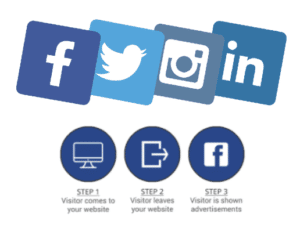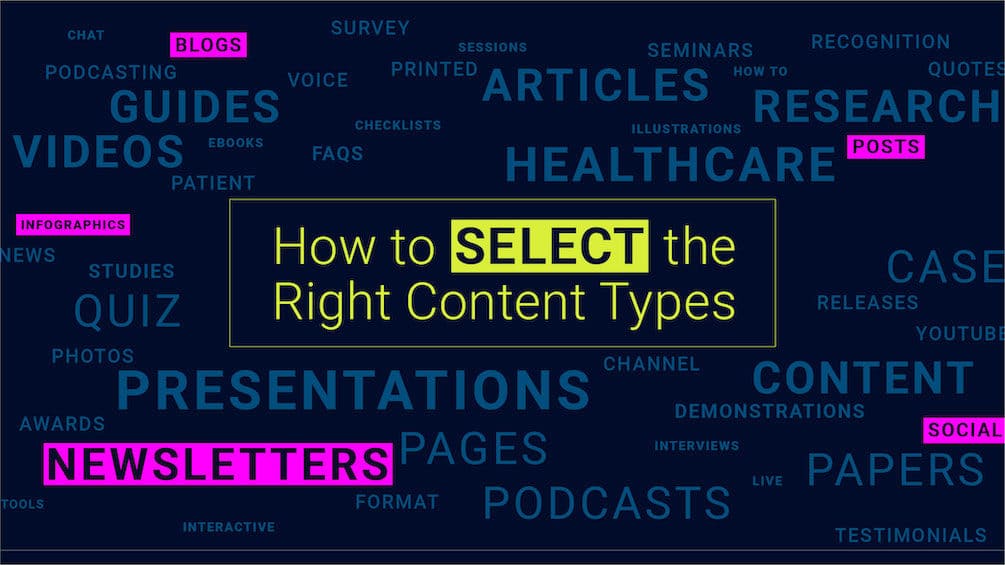How to Choose the Right Healthcare Content Types for Your Marketing Message
A strong content marketing strategy includes a plan for picking the right assets for the job. While you might have worked hard to develop a brand message, the medium you tell that story through is just as important.
But how do you know if you should create a blog post or a web page? Do you need a video or an infographic? While content marketing is growing in popularity, healthcare content marketing is more challenging than ever. It is often highly scrutinized externally by regulators and internally by executive leadership, legal and compliance teams.
In this guide to healthcare content types, we share four ways to match your message with the best content asset.
But before we dive, do you have a solid content strategy and writing style guide?
If you’re not sure where to start, read our first blog in this series on How to Build a Content Marketing Strategy: A 10 Step Guide to establish a strategy and consensus.
And when you’re ready, inform your strategy by communicating with them through the best possible formats.
Four Strategies for Choosing Healthcare Content Types
- Consider Your Target Audience
- Determine the Purpose
- Use the Marketing Funnel
- Make the Most out of Your Content
1. Know Your Target Audience
Identifying the audience has always been a fundamental copywriting skill. And while it’s valuable for informing the content itself, the research can also give you insight into the types of content your audience wants or likes to consume.
As you develop personas and ideal customer profiles, dig deeper into learning what type of content they are already consuming and what they want. The answers will help you segment your audiences to craft relevant content assets to suit their interests and needs.
Here is a little insight into two major target audiences in the healthcare industry:
Physicians
Healthcare marketing professionals know marketing and selling to doctors is particularly difficult. Everyone wants to reach them; they are time-pressed, cost-measured, and often protected by gatekeepers. The last thing they want or need is to be sold to.
Conversely, they care about data and facts, what their peers think, credible and third-party validation.
Providing you check all these boxes, an offer to a solution that makes their lives easier and helps grow revenue will more likely be welcomed.
Consumers
Many healthcare organizations struggle to produce engaging content. They may have the right “type” of content, such as the right length, keywords, and even rank high in organic search but cannot convert website visitors into customers. Why? They fail to align their message with the patient’s or customer’s needs in their journey, or if too promotional, ruin the customer experience on their site.
The massive demand for health and wellness information has only increased during the COVID-19 pandemic. And with much shorter digital attention spans, ever-changing consumer preferences, and competing priorities, how do you create content that aligns with your marketing objectives and the audience’s needs?
Healthcare content marketers must take a more modern approach with highly customized and targeted strategies when reaching their audiences.
2. Determine the Purpose
Along with defining and understanding your target audience, another way to choose the right content types for your message is to identify the purpose of the message.
The key here is to be specific about your purpose. Trying to do too much with your content will make it hard for your copywriters and content strategists to achieve goals.
Here are four basic message types and the most suitable content assets for the job.
- Educational
- Informational
- Announcement and News
- Events
1. Educational Content
As with so many aspects relating to healthcare today, COVID-19 forever changed consumer relationships with their HCPs. Content strategy has shifted to help guide consumers with prevention and care.
Educational content is also valuable for search engine optimization and driving traffic to your website. Healthcare content that is educational is usually clear, accessible, information written in plain language. Remember, there’s already a lot of great educational content out there produced by leading healthcare brands. To break through the clutter, you’ll need to create engaging, unique, and high-quality content. And you need to pick the right content types to launch your campaign.
Healthcare content marketers can leverage a wide range of content formats to reach their audience depending on the type of educational message.
A few examples include but are not limited to:
Types of Educational Content in Health and Wellness Sectors
- Health Services
- Medical Procedures
- Diseases and Conditions
- Health Treatments
- Drugs and Supplements
- Lifestyle Tips
- Appointment Processes
- What to Expect
- Patient and Visitor Guides
- Clinical Trials
Content Assets for Educational Content
Here are just some of the content types best suited for educational materials for patients or physicians.
- Website Landing Pages
- Online How-to Guides
- White Papers
- eBooks
- Blog Posts
- Health Resource Center/Knowledge Library Articles
- Brochures
- Videos
2. Informational Content
Informational content is just that, information that is useful to the target audience. Most informational content is accessible, to the point, and easy to understand.
Unlike educational content that might be engaging and insightful, informational content provides the reader with exactly what they’re looking for, such as a phone number, address, or a doctor’s name.
Types of Informational Content
- Billing and Insurance
- Medical Departments and Centers
- About Us (Mission and Vision/Physician Bios)
- Contact Us (Locations & Contact Information)
Types of Information Content Assets
- Website Landing Pages
- About Us website pages
- Contact Us website pages
- Website Location Pages
3. Announcement and News
Types of Healthcare Announcements and News
- Health Guideline Updates
- New Locations
- New Services/Products/Treatments
- New Staff/Physicians
- Milestones/Anniversaries
- Awards
Content Assets for Announcements and News
- Articles
- Blog Posts
- Social Media Posts
- eNewsletters
- Press Releases
4. Events
Healthcare Events
- Staff Events
- Fundraisers
- Community Events
Content Assets for Events
- Email Marketing
- Newsletters
- Social Media Posts
- Website Events Page
3. Consider the marketing funnel.
One of the most effective ways to build purposeful content is understanding your buyer’s behavior. Where do they go for information, and how do they “consume” it as they move through the funnel from awareness and interest to consideration and decision? Considering their needs at every stage of the buyer’s journey is essential to developing and prioritizing personas and selecting the right content types.

Top of the Funnel
In the first stage of the customer journey, your audience is not committed. They are likely searching for information online via Google search or on their preferred social channels. Offering quality, relevant content, including SEO blog articles and visually stimulating social media posts designed to drive traffic to your website.
Middle of Funnel
At the evaluation stage, establishing your thought leadership and point of view through topical ebooks, whitepapers, and other gated assets and offers promoted via email marketing with CTAs helps drive and qualify leads.
A Side Note on Email Marketing
Email marketing is still one of the most effective channels for building your database and reaching your targeted prospects in healthcare. When done right, the audience is receptive, and the cost is low relative to other tactics. Whether you invite new prospects to learn more or welcome new clients to your practice or solution, consistency is key. By staying HIPAA compliant, providing more helpful information than soliciting, and sending correspondence out consistently, you’ll be on your way to a successful email program.
With marketing automation, you can systematically take your prospects on a nurture journey, alert reps when prospects are engaging with content, identify the best candidates with lead scoring, and improve your data with progressive profiling. Read our blog to learn more on why healthcare email marketing is (still) powerful and popular.
Bottom of Funnel
As prospects begin to build trust in your brand as they move down the funnel, they are more receptive to direct engagement with your organization. Webinars, events, and demos provide opportunities to share your expertise and help qualify prospects willing to commit now their time and consideration of your product or service.
Consider the right content formats to deliver your message and map to the customer’s journey.
Just as the principles of design suggest, “form follows function”—in which the shape should relate to its intended function or purpose—determining which type or format of content to create all depends on the channel your prospect typically uses to find or consume this information. Conversely, some channels may not support the type of content you want to publish. This example illustrates how to align content types through the buyer’s journey:

4. Make the most of your content.
While the tendency may be to think more is more when feeding your content engine, syndicating and repurposing is the key to driving a higher return on your content marketing investment.
Repurposing an existing asset can extend your content lifecycle and introduce it anew to another audience and medium. Consider reformatting existing content for another channel, breaking apart an extensive report into more visual infographics or snackable social tiles, or pulling together smaller pieces into a year-in-review round-up. The options are only limited to your imagination.
Also, keep in mind, content marketing is not limited to your website. Leverage the digital channels, social platforms, and influencers your audiences subscribe to.
 Digital marketing is essential to reach today’s buyers. Omnipresent and always on, it’s a cost-effective and scalable way to reach doctors during this time and any other. Not only is it easy to track and attribute, but it is also a great equalizer when trying to build your brand to a highly defined audience. Face-to-face selling can be inadvertently rewarded, though access so limited or even restricted in today’s climate is simply becoming less scalable or economically viable.
Digital marketing is essential to reach today’s buyers. Omnipresent and always on, it’s a cost-effective and scalable way to reach doctors during this time and any other. Not only is it easy to track and attribute, but it is also a great equalizer when trying to build your brand to a highly defined audience. Face-to-face selling can be inadvertently rewarded, though access so limited or even restricted in today’s climate is simply becoming less scalable or economically viable.
Paid social and digital advertising can help you reach personal and business emails across all devices. By advertising on social channels like Facebook, Instagram, Twitter, LinkedIn, you can stay in front of your audience and drive website traffic. You can also retarget website visitors later as they browse social media to bring them back. Not to mention those who search for health information online also tend to be educated consumers.
We Can Help
Marketing in this new and evolving digital era requires an investment of time and effort by hospitals and other healthcare organizations. If you don’t have the time, resources, ability, or focus to do it alone and want to explore how to help with our content marketing services, CONTACT US to get started.








